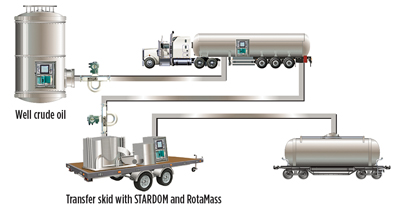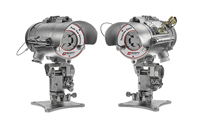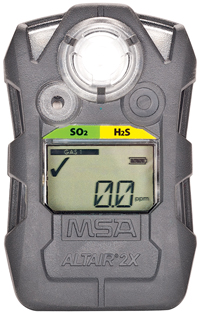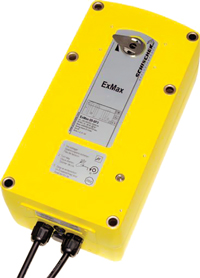what’s new in gas processing technology
H. Meche, Associate Editor
Oil transloading process targets oil and gas

Yokogawa Corp. of America offers a panel-packaged solution for metering truck or railcar unloading and loading, based on the FCN-remote terminal unit (RTU) low-power autonomous controller of the STARDOM network-based control system. This packaged solution has been developed to meet the requirements of clients in the upstream oil and gas industries, and it complies with API MPMS 11.1, 11.4 and 20.1, as well as ERCB Directive 17 guidelines.
Yokogawa’s approach packages a 4s reliability net oil computer with a standard panel containing all the components needed to bring in flow, temperature, pressure, valve and permissive input/output to create a net oil metering solution. This reduces the delivery time to six weeks or better and delivers a preconfigured package where parameters can be easily reconfigured, instead of requiring full engineering and programming at the site.
The panel-packaged solution is preconfigured for four different types of Coriolis and water-cut meters. It is configurable for up to four different salinity/brine density calculation methods, supports one year of data logging for each transaction, and supports e-tickets/logs and paper-printed tickets.
Additionally, the solution is suitable for use in temperatures ranging from –20°C to 70°C. It supports standalone and networked database and logging solutions, operates in 0% to 16%+ salinity and covers a range of fluids.
www.yokogawa.com/us
Detector’s optical units find combustible gases

Scott Safety’s Spyglass open-path combustible gas detector has two optical units—an infrared (IR) light source and an IR detector. The units are separated by a distance, and they work together to detect combustible gases in the atmosphere between them.
The Spyglass system detects hydrocarbon gases by analyzing the radiation absorption caused by gases in the atmosphere and comparing this absorption to background atmospheric absorption. This process is accomplished between a pair of units: a flash source, and a detector that can monitor a distance of up to 200 m.
For line-of-sight applications, such as fenceline and pipeline monitoring, the Spyglass open-path detector can replace up to 20 fixed-point detectors. The system has minimal maintenance requirements that include periodic cleaning of the unit’s lenses, an alignment check, and the replacement of one consumable sensor with a 10-year life. This results in reduced lifetime maintenance costs for users.
The Spyglass open-path combustible gas detector is offered in four basic models, designed to cover different ranges: Model 20 (7 m–20 m), Model 40 (15 m–40 m), Model 100 (35 m–100 m) and Model 200 (80 m–200 m).
www.scottsafety.com
Detector features standalone bump test

MSA’s ALTAIR 2X platform of gas detectors include one-gas and two-gas detectors that incorporate XCell sensor technology to increase durability and deliver enhanced worker safety, compliance and traceability.
The ALTAIR 2XP gas detector (with XCell pulse technology) is said to deliver the world’s first standalone bump test. It allows for daily bump testing without the need for calibration accessories or bottled calibration gas.
The ALTAIR 2XT gas detector eliminates the need for a second detector by using proven XCell two-tox sensors. They detect two gases on distinct sensor channels with digital output, minimizing cross-channel interference.
Furthermore, in the ALTAIR 2X single-gas detector, the sensors’ controlling electronics are miniaturized and placed inside the sensor itself using MSA’s application-specific integrated circuit design.
www.msasafety.com
Seals group acquires polymer expertise
The Saint-Gobain Seals Group has added expertise to its polymer product lines through the acquisition of LS Kunststofftechnologie GmbH, a German manufacturer of high-performance polymer components for the industrial
and other markets.
Seal rings are found in different markets and applications where leakage is critical, including reciprocating compressors for distributing natural gas (i.e., floating production, storage, and offloading vessel compressors), industrial refrigeration compressors and more. Depending on working conditions (such as temperature, pressure, speed and chemicals involved), targeted leakage and the volumes required, the Seals Group offers a range of materials for these applications.
Materials such as Rulon, fluoropolymer compounds, Meldin HT and thermoplastic materials (based on PPS, PEEK and PAI), as well as the Meldin 7000 series and thermoset polyimide materials, are being used more often to replace metal rings. They provide lighter solutions to reduce energy consumption and allow greater design flexibility.
www.seals.saint-gobain.com
Valve accommodates range of compressor speeds

Dresser-Rand’s Magnum HammerHead valve is designed for high-molecular-weight applications at low and high compressor speeds, and it can be applied to all brands of reciprocating compressors.
The HammerHead valve’s geometry was developed using computational fluid dynamics and finite element analysis, improving the valve flow area by as much as 60% compared to standard Magnum valves. The valve’s element design minimizes tensile stresses, while the streamlined flow path, with optimized seat, guard and lift areas, maximizes the valve flow area and is more tolerant of particles and liquids in the gas.
Only one element is used for all valve sizes. This simplifies inventory management, minimizing replacement costs and increasing interchangeability. Precision-guided elements and springs increase the reliability of moving parts for long-term valve operation.
The results delivered by the new valves include lower power consumption and a corresponding increase in compressor flow. In addition, several clients have benefitted from improved valve reliability and compressor efficiencies after upgrading to the new valve.
www.dresser-rand.com
Compact actuators available for LNG valves

A liquefied natural gas (LNG) regasification system, together with auxiliary processes, uses scores of valves. These valves are typically small, cryogenic and tightly arranged within a compact installation. Automated valves require a compact and fast-acting actuator, capable of providing rotary or linear drive, for isolating and modulating duties in a hazardous environment.
The Rotork Schischek range of electric actuators features small sizes, flexible power-supply ranges, failsafe capabilities and explosion-proof approvals. ExMax (quarter-turn) and ExRun (linear) actuators are available for process applications handling LNG in cryogenic environments.
The Schischek universal power supply has a range of 24 volts–230 volts, and alternating current and direct current. Explosion-proof certification for Schischek actuators encompasses UL, CSA, ATEX, IECEx, GOST/RTN, INMETRO and KOSHA international standards, with safety integrity levels up to SIL 3 also available with failsafe products.
Valve stroke times are between 1 second and 120 seconds, depending on the actuator model. All models are fitted as standard with internal heaters, enabling cryogenic operation at ambient temperatures down to –40°C.
www.schischek.com
Coatings available for Hg, H2S sampling
Laboratory testing and field results show that SilcoNert 2000 treated surfaces are inert to mercury (Hg), hydrogen sulfide (H2S), mercaptans and other active compounds. The coating features accurate grading of feedstock, detection of process upsets and gas stream qualification for improved yield.
SilcoTek coatings can be applied to intricate surfaces while maintaining the precise tolerances found in gas process monitoring and instrumentation. The coatings can be used on most components found in mercury-sampling and sulfur-sampling systems. These components include process sample probes/housings, impingers, tubing and fittings, regulators, valves, filters, sample cylinders and storage containers, downhole samplers, and flare gas and stack probes.
www.SilcoTek.com/GP
Dual-tip flare serves many gas applications
ABUTEC’s produced gas dual-tip flare is designed for use with multi-pad wells, high-flow applications, variable-flow applications and dual-flow applications, as well as produced gas and storage tank vapors.
The flare combusts produced gas (both high-pressure and high-flow) as well as tank vapor with low pressure. It handles more than 1 million standard cubic feet per day (MMscfd), or 68 million British thermal units per hour (Btu/hr), of produced gas, and 100 thousand standard cubic feet per day (Mscfd), or 9.2 million Btu/hr, of tank gas.
Additionally, the flare’s design allows for high-pressure burners and low-pressure enclosed combustors, along with pilots for use as either a complete unit or as independent units.
www.abutec.com/products




Comments